NORTH WALES COAST RAILWAY:NOTICE BOARD
Rheilffordd arfordir gogledd Cymru: Hysbysfwrdd
07 Decenber 2020





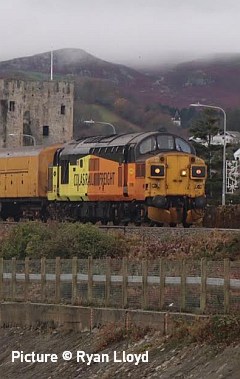
Forthcoming events
(see also our Calendar page for venues)
Note: we have removed all entries relating to meetings as the events are cancelled.
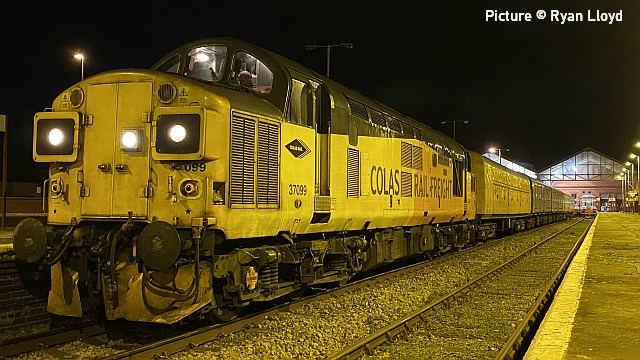
37 099 at Llandudno, 3 December. Picture by Ryan Lloyd.
Some items have been held over due to time spent attending a (Zoom) Community Rail event. Expect an extra issue at the weekend. - Charlie
Mk4 coach test run
[Stop press: now running only to Crewe via Chester.]
One of the Mk4 carriage sets intended for Premier Express workings will be venturing out with a Class 67 loco on a full-distance test run on Thursday 10 December as 1Z48 07:09 Canton - Holyhead and returning as 1Z49 12:39 Holyhead - Canton. On the outward journey, the train is booked to sit at Wrexham for 20 minutes, but this may be altered to Ruabon. The set to be used is 'HD03' which is still in its modified formation DVT - TO - POD - SV - TOE - Loco.
The trains will be running as 'class 1' (express passenger) due to on-board Passenger Information system testing that can only be done if the train is running as a class 1 service - it definitely won’t be open for customers!
37 on the Coast
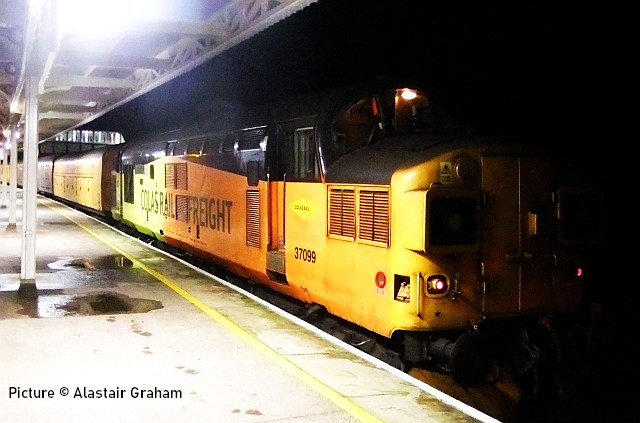
On the evening of 2 December, 37 099 with its Ultrasonic Test Train pauses at Llandudno Junction on the way to Bangor where it spent the night
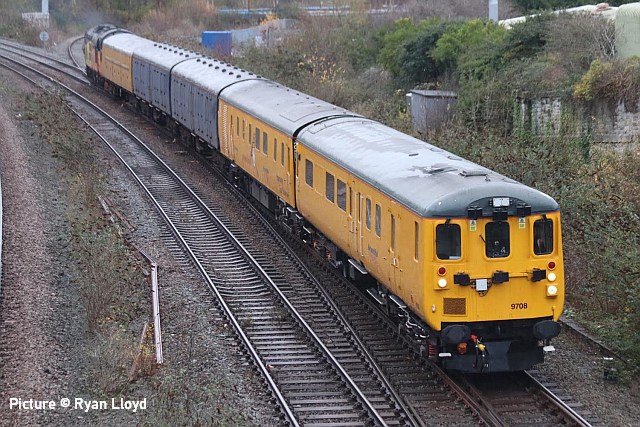
On 3 December 37 099 and driving trailer 9708 book-ended train 3Q94 Bangor to Crewe via the Conwy Valley approaching Llandudno Junction ...
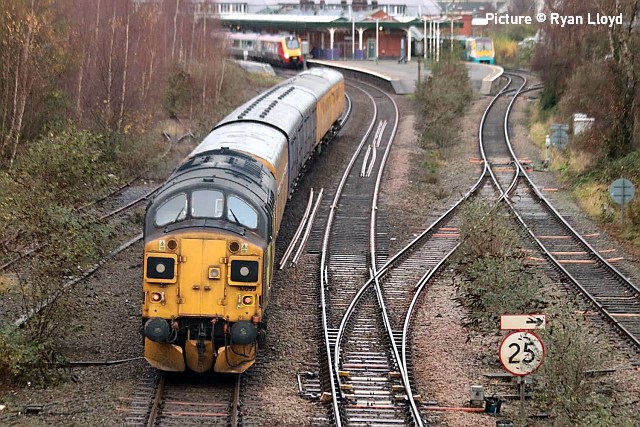
... and arriving on to platform 4 from the Conwy Valley line (Ryan Lloyd).
RHTT news
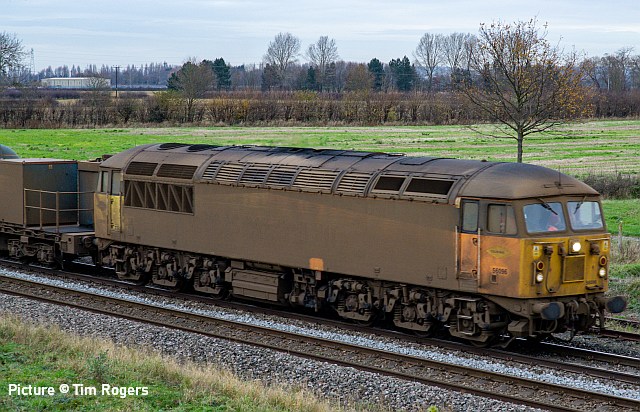
1 December, 56 096 near Sandycroft ...
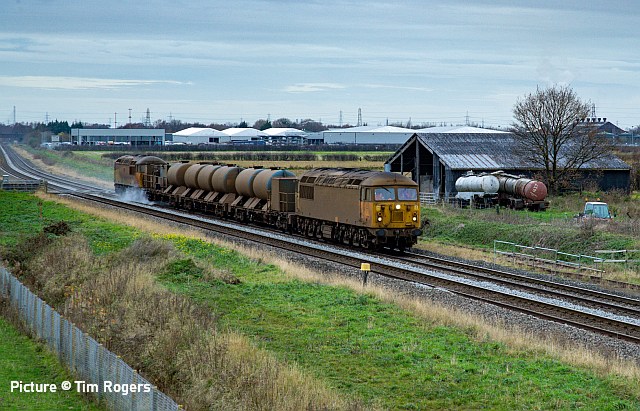
... on the rear, 56 302 Peco (Tim Rogers).
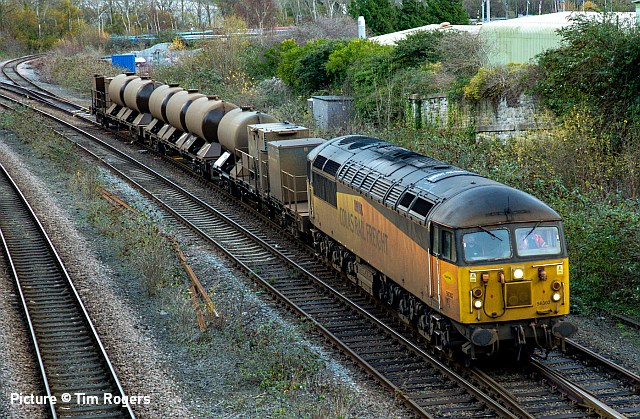
On 2 December 56 302 found itself working alone (Tim Rogers).
Looking back: Early Festiniog Days - with David Pool
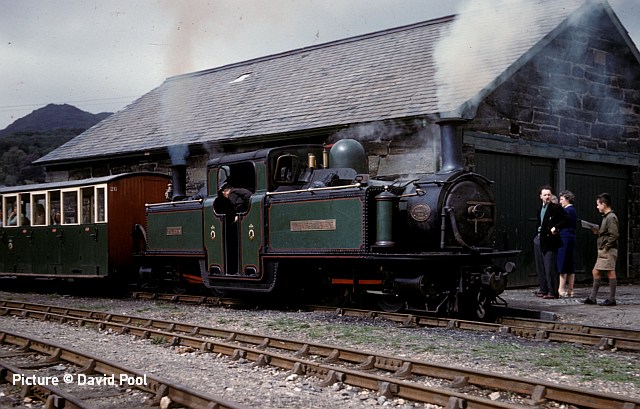
Although I first visited the Festiniog Railway in 1959, I was using black and white film, so the following year I returned with my Vito B and Kodachrome. On 25 August Taliesin was in steam, and the scene is so typical of the early days of preservation. Enthusiasts today who are familiar with the Single Fairlie of that name may not be aware of the Festiniog Railway’s habit of changing names when a locomotive is refurbished or rebuilt. This Taliesin was the Livingston Thompson, built in 1885 at Boston Lodge and renamed between 1932 and 1961. It then became Earl of Merioneth, and ran until 1971, when it was withdrawn. In 1979 a newly built locomotive assumed the latter name, and Taliesin reverted to Livingston Thompson in 1988, when it was sent to the National Railway Museum at York.
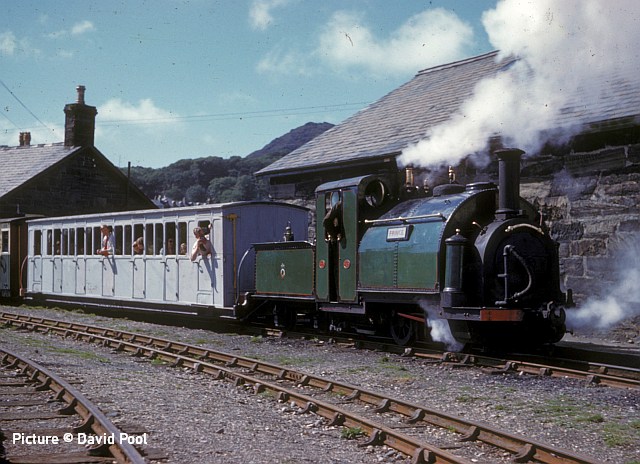
Prince was the regular locomotive used by the Festiniog Railway in the 1950s, often driven by the legendary Bill Hoole of LNER fame. On 25 August 1960 it was working a second train from Portmadoc, and the shortage of rolling stock has resulted in a newly restored coach being used before it has been fully painted. This looks like coach No. 15, originally built in 1872 and one of the first bogies coaches in Britain.
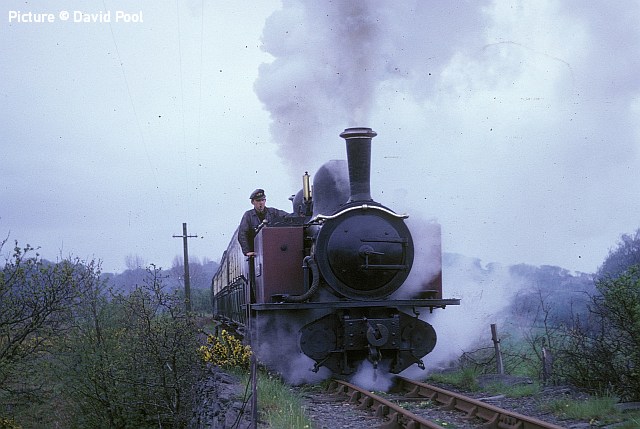
Merddin Emrys was the first Double Fairlie to be built at Boston Lodge in 1879, and was back in service on 9 May 1962, photographed leaving Minffordd. I cannot remember why a cab had not been fitted at this stage – perhaps a hot Summer was expected!
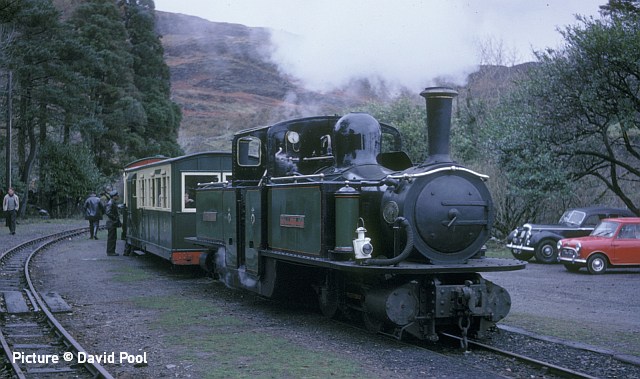
Merddin Emrys was looking more like a Festiniog engine at Tan y Bwlch on 13 April 1963, having received a proper cab with a roof, and a repaint into the usual green livery. Note the Riley and the Mini in the car park, and the Observation coach, which I think was No.11.
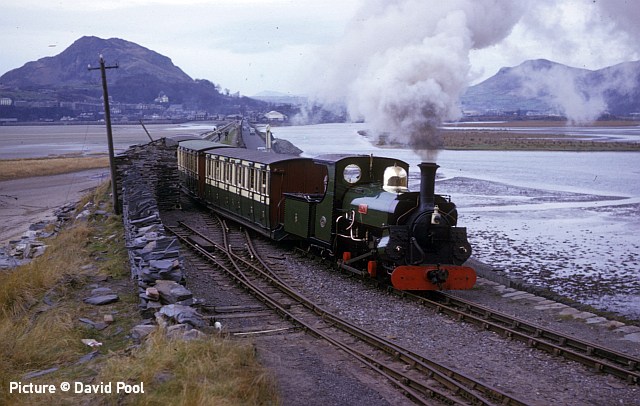
In 1963 the Penrhyn Ladies, Linda and Blanche had been bought by the FR after a year on hire. Linda was a Hunslet built in 1893 for the main line from Penrhyn Quarry to the quayside at Port Penrhyn, and when photographed passing Boston Lodge on 27 March 1964 had received a tender from what remained of Welsh Pony. In 1962 she had made her mark in Festiniog Folklore by derailing, due to a small difference in track gauge between Penrhyn and the Festiniog, and performing “Linda’s Leap”. Later in 1970 she received a Pony Truck, becoming the 2-4-0 which we know today.
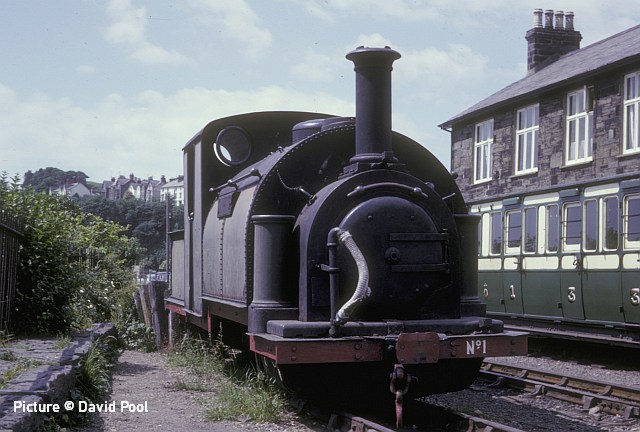
Prince, Palmerston and now Welsh Pony are well known, but we should not forget the first England locomotive Princess, dating from 1863. No.1 has not worked since hauling the last train before closure in 1946, and has since then been cosmetically restored and occasionally displayed as an ambassador for the Railway. On 3 July 1965 it was photographed at Portmadoc Harbour Station.
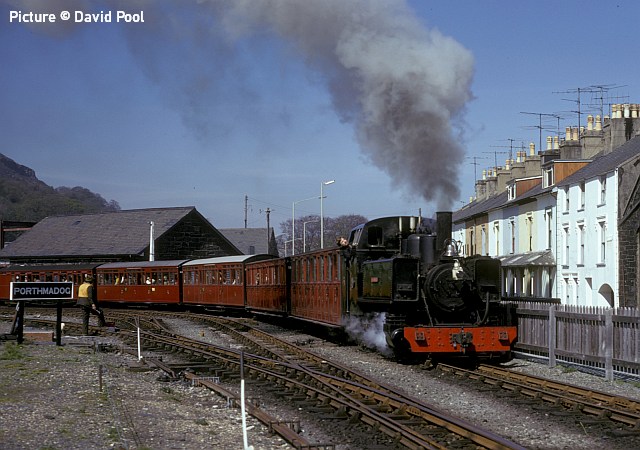
By 1974 Portmadoc had become Porthmadog, and a new Mountaineer had arrived. One of the original England locomotives of 1863 had been No. 3 Mountaineer, but had not survived, so when an Alco locomotive built for the War Department in 1916 was offered to the Festiniog Railway in 1967 it was gratefully received and refurbished. It was fitted with replica nameplates and carried the bell from the original Mountaineer when photographed on 14 April 1974. It had been converted to oil burning in 1972, and ran on both the Festiniog and Welsh Highland Railways until it was eventually withdrawn in 2006. It would be possible to convert it back to coal firing in view of the environmental problems and cost of oil, but no decision has yet been announced.
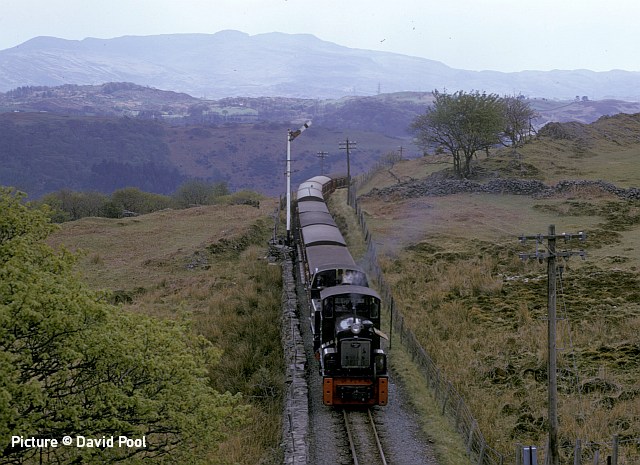
The Deviation was under construction in 1974, and the terminus was now Dduallt. This was the first of my many treks to Dduallt, which provides so many photo opportunities to compensate for the exertions in getting there! On 27 April 1974 I was expecting to see Mountaineer on the early afternoon train from Porthmadog, and took up a position on a bridge of the Spiral. The approaching noise was definitely not Mountaineer, and Upnor Castle duly appeared hauling a long train with Mountaineer on the back. It was understandable why it had become known as “Uproar”! The British Rail signal was a feature at Dduallt for several years, the height being needed to assist visibility on the curves, but was rather incongruous and no doubt has now found a good home on another railway. Does anybody know where?
Jersey - Holyhead Potato Traffic - by Charlie Hulme
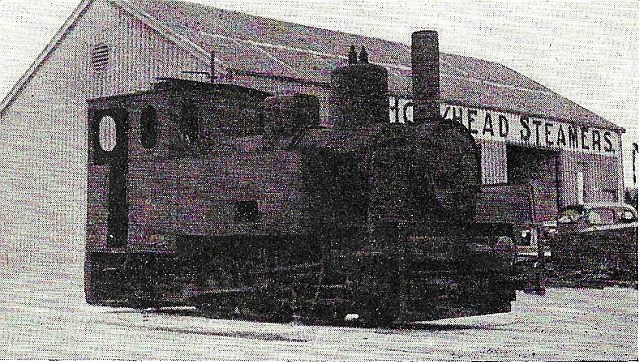
Michael Davies, a fellow member of the Manchester Locomotive Society, discovered across the image above in the November - December 1946 issue of Railway Magazine, and posted on the Society's email group asking for any information.
The picture's caption states that it was a locomotive used on Jersey to work ammunition trains, and abandoned on the dockside by the Germans. The locomotive is a metre-gauge 0-6-0T, possibly one of several brought to the island during German occupation from the Chemin de Fer du Finisterre in France. But why the legend 'Holyhead Steamers' on the warehouse behind?
I found a clue to the answer in a newspaper of 1887:
A new enterprise has been started at Holyhead. Steamers from Jersey areFrom other newspaper reports it's clear that new potatoes were the principal traffic, commencing in June each year.
to come there to discharge new potatoes and garden produce which will be immediately distributed by the London and North Western Company all over England and Ireland.
The Carnarvon and Denbigh Herald in June 1899 reports:
The Jersey boats in the new potato trade have commenced plying between Jersey and this port. The first steamer arrived at Holyhead, on Wednesday last with the largest consignment ever brought here at the commencement of the season, and it is expected that the cargoes will be large this season.Elsewhere we read that the Fleetwood, Holyhead, and Jersey Steampacket Company were engaged in the twice-weekly traffic, and that special trains would run to different parts of the country. An interesting photograph in the National Railway Museum collection dated 1909 shows boy dockers with trolleys loaded with barrels of Jersey potatoes which have been unloaded from the steamer SS Dearne. The potatoes, sorted by size, are being transferred directly to a freight train waiting at the goods depot platform. Another report says that a ship-load could be as many as 16,000 of these barrels. Does anyone have information about these trains?
The Dearne, built in the year of the picture, was in the Lancashire and Yorkshire Railway's fleet, normally based at Goole for the continental trade. (This document from the East Riding Museum refers.) On the outbreak of war in 1914 the ship was in Hamburg, and was seized by the Germans and all her crew interned. She was used by the Germans as a cargo vessel, until torpedoed and sunk by a British submarine in December 1915. Another L & Y Goole vessel, mentioned in 1910, was the SS Irwell, which survived until 1954 in BR ownership. By 1911, some potato ships were reaching Manchester by the Ship Canal, although customers were compalining that this took longer than trans-shipment at Holyhead.
Whether the Jersey potato trade to Holyhead resumed after World War One I don't know, there are no newspaper references to be found.
Trains to Dolgellau?
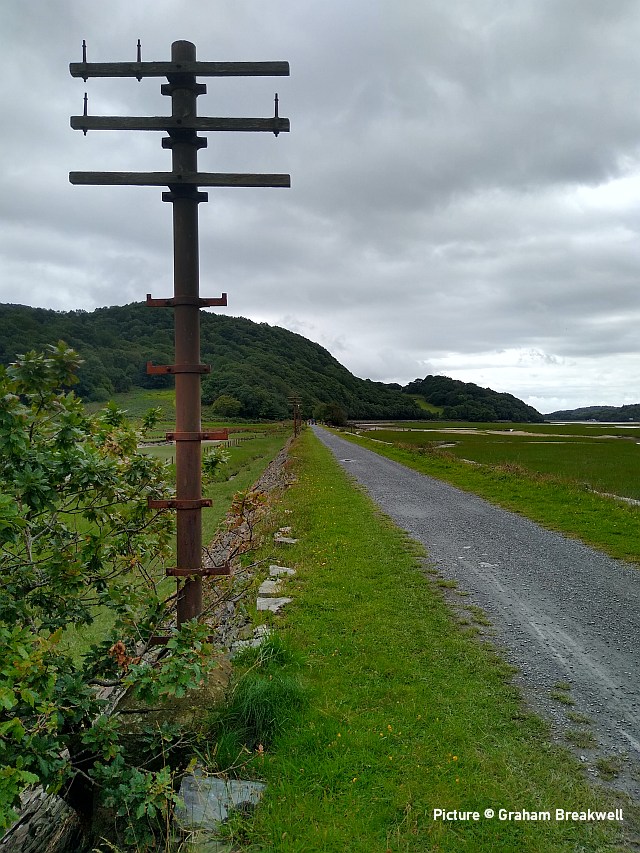
According to an article in Moden Railways magazine, the Welsh Government are considering a number of rail re-openings to improve connectivity between Anglesey, the North Wales Coast and the Cambrian system, including the key settlements Amlwch, Bangor, Caernarfon, Dolgellau, Aberystwyth, Pwllheli, Barmouth and Blaenau Ffestiniog. This would involve the re-opening of Bangor - Caernarfon - Afon Wen, Gaerwen - Amlwch and (rather oddly) Blaenau Ffestiniog - Trawsfynydd.
There are also aspirations for, among others, the Aberystwyth - Carmarthen line, presumably to form a purely Welsh north - south route. As for Morfa Mawddach - Dolgellau, most of the trackbed is not a much-loved walking and cycling path, except for a section into Dolgellau which has been covered by a road by-pass. Dolgellau is a busy historic and important town, with a population of about 3,000, but could it (with the villages of Arthog and Penmaenpool) really support a train service? There's little chance of re-opening the whole line to Ruabon, sadly.
Still, if it chosen for re-opening, at leas some of the telegraph poles are still in situ (Picture above by Graham Breakwell.) There's also the preserved signal on the edge of the quay at Penmaenpool with its sign 'Keep Off. Survivors will be prosecuted'.
North Wales Coast home page | Archive | Previous Notice Board